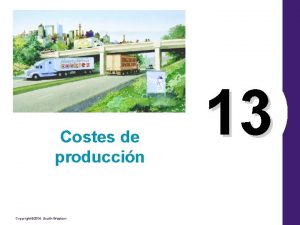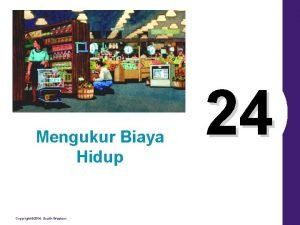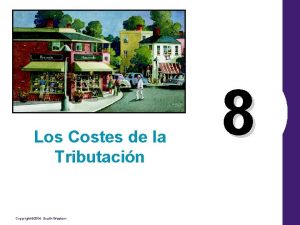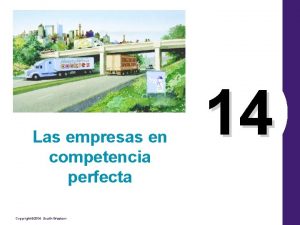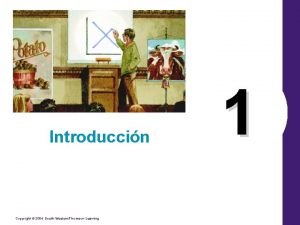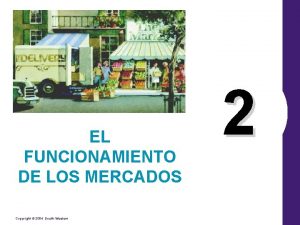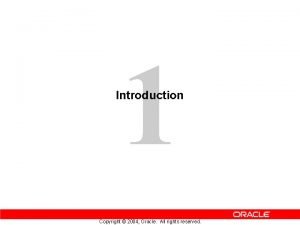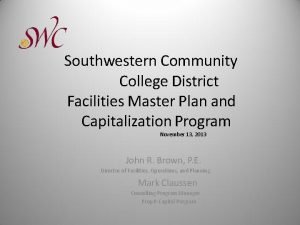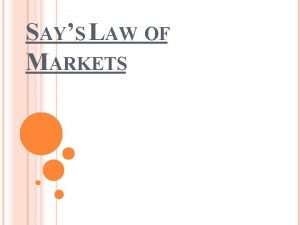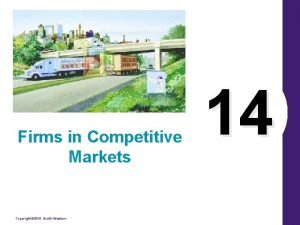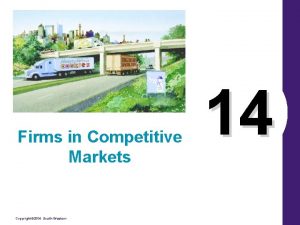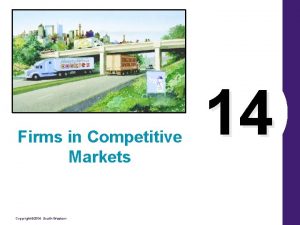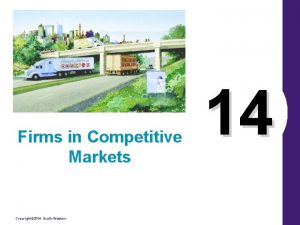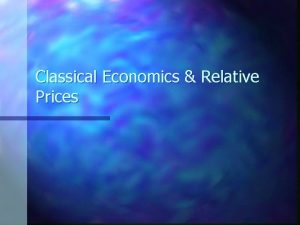Classical Says Law of Markets Copyright 2004 SouthWestern












- Slides: 12

Classical Say's Law of Markets Copyright © 2004 South-Western

1. Say’s Law of Markets ⎈ Say’s law of markets is the core of classical theory of employment. ⎈ A famous French Economist Jeane Baptiste Say enunciated the formal statement that “Supply creates its own demand. ” ⎈ It implies that the supply of goods generates sufficient income to create demand for goods equal to its supply. ⎈ Therefore, there is no possibility of overproduction and unemployment in the economy. ⎈ Even if there is some unemployment in the shortrun, the economy automatically tends towards full employment in the long-run. 2

Assumptions of Say’s Law of Markets ⎈ There is free market economy. ⎈ No government intervention. ⎈ Automatic adjustment of economic system due to flexibility of wages, interest and prices. ⎈ Extent of market is limitless. ⎈ Closed economy, no trade links with any other country, ⎈ Money is only a medium of exchange. ⎈ Validity of long-run, ⎈ Optimum allocation of resources, 3

Important facts of Say’s law ⎈ Production creates Demand for goods. With the use of inputs in production process, income is generated. This income is distributed to the owner of inputs which they ultimately spend on purchasing goods for their use. This causes demand for produced goods. This is how supply creates its own demand ⎈ Barter and monetized economy, Say’s law holds good in barter economy. It is because, goods are produced for self consumption or to get other goods in exchange for the produce. When people offer their produce in barter for other goods, they create demand for the goods. This law is also valid in monetized economy, In this economy money is used to buy or sale goods and services. 4

The inputs used in production generate money incomes in the form of wages, interest, rent and profits. The incomes are spent on purchasing the goods produced. It creates demand. It implies that if there is production, there is income and if there is income, there is demand for goods whose production creates income. Thus, supply creates its own demand in monetized economy. ⎈ No general overproduction Say’s law states that there is no general in overproduction. When there is an increase production, there is also increase in income of related factors. Consequently new demand is created and there is no general over production. General overproduction may exist in the shortrun but it is automatically adjusted by the market forces of demand supply in the long-run. 5

⎈ Saving and investment equality Generally income is spent on consumption. When some amount of income remains unspent on consumption or saved, overproduction may exists. But it is rate of interest which plays important role to make a decision for both the consumers and producers about saving and investment. How much is to save and how much is to invest, depend on rate of interest. The interaction for demand for and supply of saving as a capital determines equilibrium rate of interest in market at which the equality between saving and investment restored and there is no over production. ⎈ Labour Market Labour always seek a higher wage rate but it causes a fall in demand for labour and rise in unemployment. In a free market economy flexible rate of wages automatically restores full employment through the interaction of demand for and supply of labour 6

Implications of Say’s Law ⍟ Full employment in the economy According to Say’s law there is full employment in the economy. It is because increase in production means increase in employment and production continues until the full employment is reached. In such a condition production will be maximum. ⍟ Proper utilization of resources This law is based on full employment in the economy. According to which the proper utilization of idle resources are ensured which will further help to produce more and also generate more income. ⍟ No general overproduction There is no general overproduction and no unemployment. Increase in production generates income for inputs and further demand is created for the produce. 7

⍟ Self adjustment mechanism Say’s law the According self adjustment mechanism brings up equilibrium in different markets. So disequilibrium is a temporary situation. In a capital market equality between saving and investment is restored by the flexible interest rate while in labour market equality between demand for and supply of labour is maintained by the wage rate. ⍟ Wage cut creates full employment This law assumes that wage-cut helps to restore full employment by reducing production cost and price level and increasing demand for goods. It denies the wage rigidity policy in the economy. ⍟ Neutral role of money This law is based on barter system where goods are exchanged for goods. There is also assumed that money is just a medium of exchange; it does not affect the production process. So the role of money is neutral. 8

Criticism of Say’s Law of Markets Say’s law was criticized by J. M. Keynes on the following grounds. � Supply does not create its demand Say’s law states that supply creates its demand but Keynes disagrees with this view. According to Keynes in modern times, demand does not increase as much as production increases. It is also not possible to consumes the goods produced in domestic economy. � Self-adjustment is not possible. Say’s law assumes that shelf-adjustment mechanism maintains full employment in the long-run. But according to Keynes employment can be increased by increasing in the rate of investment not by shelf- adjustment mechanism in the long run. Neither he was in favor of long-run nor he believed that we are all alive in the long-run. 9

� Money is not neutral. Say’s law assumes that the role of money is neutral and it does not effect the economic activities. Keynes gives due important to money. According to him, money is held for income and business motives. Individuals hold money for unforeseen contingencies. Businessmen hold cash in reserve for future purpose. So money is not neutral, it affect economic activities. � Overproduction is possible. Say’s law denies the possibility of overproduction but Keynes is in against it. He believes that whole factor-income is not spent. A portion of income is saved but it is not automatically invested. Therefore, saving and investment are always not in equality. Hence the problem of overproduction and unemployment remain in the economy. 10

� Need of state intervention Say’s law is based on free market policy but Keynes has focused on the need of the intervention of state at times of overproduction and mass unemployment through fiscal and monetary policies. � Wage-cut is not favorable Supporting says law, Pigou favored a wage-cut policy to solve the unemployment problem. But Keynes is not in favor of wage-cut policy. He believes that wagecut brings deficiency in aggregate demand which increases unemployment instead of removing it. So wage-cut is not favorable. � Saving and investment equality through income Keynes opposes Say’s view that saving and investment equality is restored through rate of interest. He advocates, it is change in income rather than rate of interest which bring about equality in them. 11

� Unemployment Situation According to Keynes full employment is a special case because in capitalist economies, unemployment is is fount existing. Capitalist economies are not found functioning according to says law and supply always higher than its demand. Therefore many workers are willing to work at current wage rate but remain unemployed. 12


